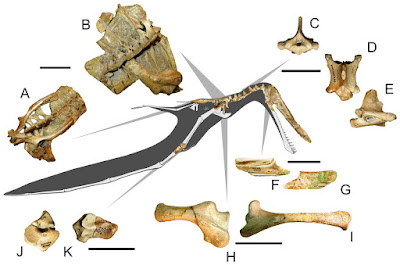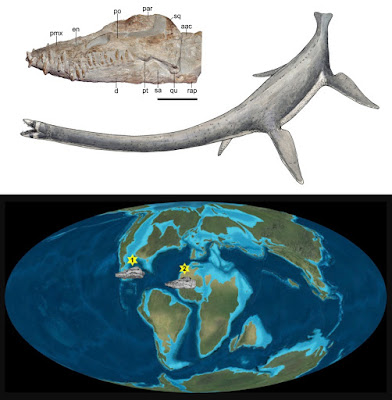[Most Recent Entries] [Calendar View]
Sunday, May 7th, 2017
| Time | Event | ||||
| 9:02a | [Paleontology • 2017] Anhanguera Taxonomy Revisited: Is Our Understanding of Santana Group Pterosaur Diversity Biased by Poor Biological and Stratigraphic Control?
Abstract Background Anhanguerids comprise an important clade of pterosaurs, mostly known from dozens of three-dimensionally preserved specimens recovered from the Lower Cretaceous Romualdo Formation (northeastern Brazil). They are remarkably diverse in this sedimentary unit, with eight named species, six of them belonging to the genus Anhanguera. However, such diversity is likely overestimated, as these species have been historically diagnosed based on subtle differences, mainly based on the shape and position of the cranial crest. In spite of that, recently discovered pterosaur taxa represented by large numbers of individuals, including juveniles and adults, as well as presumed males and females, have crests of sizes and shapes that are either ontogenetically variable or sexually dimorphic. Methods We describe in detail the skull of one of the most complete specimens referred to Anhanguera, AMNH 22555, and use it as a case study to review the diversity of anhanguerids from the Romualdo Formation. In order to accomplish that, a geometric morphometric analysis was performed to assess size-dependent characters with respect to the premaxillary crest in the 12 most complete skulls bearing crests that are referred in, or related to, this clade, almost all of them analyzed first hand. Results Geometric morphometric regression of shape on centroid size was highly statistically significant (p = 0.0091) and showed that allometry accounts for 25.7% of total shape variation between skulls of different centroid sizes. Premaxillary crests are both taller and anteroposteriorly longer in larger skulls, a feature consistent with ontogenetic growth. A new diagnosis is proposed for Anhanguera, including traits that are nowadays known to be widespread within the genus, as well as ontogenetic changes. AMNH 22555 cannot be referred to “Anhanguera santanae” and, in fact, “Anhanguera santanae”, “Anhanguera araripensis”, and “Anhanguera robustus” are here considered nomina dubia. Discussion Historically, minor differences in crest morphology have been used in the definition of new anhanguerid species. Nowadays, this practice resulted in a considerable difficulty in referring well-preserved skulls into known taxa. When several specimens are analyzed, morphologies previously believed to be disparate are, in fact, separated by a continuum, and are thus better explained as individual or temporal variations. Stratigraphically controlled excavations on the Romualdo Formation have showed evidence for faunal turnover regarding fish communities. It is thus possible that some of the pterosaurs from this unit were not coeval, and might even represent anagenetic morphotypes. Unfortunately, amateur collecting of Romualdo Formation fossils, aimed especially at commerce, resulted in the lack of stratigraphic data of virtually all its pterosaurs and precludes testing of these further hypotheses. Felipe L. Pinheiro and Taissa Rodrigues. 2017. Anhanguera Taxonomy Revisited: Is Our Understanding of Santana Group Pterosaur Diversity Biased by Poor Biological and Stratigraphic Control? PeerJ. 5:e3285. DOI: 10.7717/peerj.3285 | ||||
| 9:26a | [Paleontology • 2017] Redescription of the Elasmosaurid Plesiosaurian Libonectes atlasense from the Upper Cretaceous of Morocco
Highlights • The Late Cretaceous elasmosaurid species Libonectes atlasense and Libonectes morgani are likely synonymous. • Fossils assigned to Libonectes morgani collectively constitute one of the best-known Elasmosaurid taxa. • The palaeogeographical distribution of Libonectes morgani evidences trans-Atlantic dispersal amongst multiple Late Cretaceous plesiosaurian clades. Abstract The holotype of Libonectes atlasense is an almost complete skeleton from Upper Cretaceous (mid-Turonian) rocks of the Goulmima area in eastern Morocco. Initial assessment of this specimen in 2005 proposed generic referral based on stratigraphical contemporaneity with Libonectes morgani from the Cenomanian–Turonian of Texas, U.S.A. Nevertheless, relative differences in the profile of the premaxillary-maxillary tooth row, position of the external bony nasal opening, number of teeth and rostral inclination of the mandibular symphysis, proportions of the axial neural arch, and number of cervical and pectoral vertebrae were used to distinguish between these species. As part of an on-going comparative appraisal of elasmosaurid plesiosaurian osteo-anatomy, we re-examined the type and formally referred material of both L. atlasense and L. morgani in order to establish species validity, as well as compile a comparative atlas for use in future works. Our inspections revealed that these reportedly distinct species-level fossils are in fact virtually indistinguishable in gross morphology. Indeed, the only substantial difference occurs in relative prominence of the midline keel along the mandibular symphysis, which might be explained by intraspecific variation. Furthermore, our observations permit an amendment to the published generic diagnosis of Libonectes with the confirmation of important states such as the likely presence of a pectoral bar, distocaudal expansion of the humerus, and an epipodial foramen. In addition, novel features include a prominent ‘prong-like’ ventral midline process on the coracoids, and the development of a median pelvic bar that encloses a central fenestration. The composite remains of L. morgani thus constitute one of the most complete elasmosaurid skeletal hypodigms documented worldwide, and evidence a trans-Atlantic distribution for this apparently dispersive species during the early–Late Cretaceous.
Sven Sachs and Benjamin P. Kear. 2017. Redescription of the Elasmosaurid Plesiosaurian Libonectes atlasense from the Upper Cretaceous of Morocco. Cretaceous Research. 74; 205–222. DOI: 10.1016/j.cretres.2017.02.017 |
| << Previous Day |
2017/05/07 [Calendar] |
Next Day >> |



